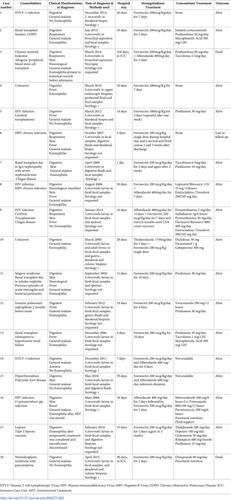PLOS Neglected Tropical Diseases ( IF 3.4 ) Pub Date : 2018-02-23 , DOI: 10.1371/journal.pntd.0006272 Angela Martinez-Perez 1 , Silvia Roure Díez 2 , Moncef Belhassen-Garcia 3 , Diego Torrús-Tendero 4 , Jose Luis Perez-Arellano 5 , Teresa Cabezas 6 , Cristina Soler 7 , Marta Díaz-Menéndez 8 , Miriam Navarro 9 , Begoña Treviño 10 , Fernando Salvador 11 ,

|
Introduction
Strongyloides stercoralis is a globally distributed nematode that causes diverse clinical symptoms in humans. Spain, once considered an endemic country, has experienced a recent increase in imported cases. The introduction of serology helps diagnosis and is currently replacing microbiological techniques in some settings, but its sensitivity is variable and can be low in immunocompromised patients. Diagnosis can only be confirmed by identification of larvae. Often, this “gold standard” can only be achieved in severe cases, such as disseminated S.stercoralis infection, or S.stercoralis hyperinfection syndrome, where parasite load is high. In addition, these clinical presentations are not well-defined. Our aim is to describe severe cases of S.stercoralis, their epidemiological profile, and their clinical details.
Methods
An observational retrospective study of disseminated S.stercoralis infection, or hyperinfection syndrome. Inclusion criteria: aged over 18, with a diagnosis of disseminated S.stercoralis infection, or hyperinfection syndrome, confirmed by visualization of larvae. Patients were identified through revision of clinical records for the period 2000–2015, in collaboration with eight reference centers throughout Spain.
Results
From the period 2000–2015, eighteen cases were identified, 66.7% of which were male, with a median age of 40 (range 21–70). Most of them were foreigners (94.4%), mainly from Latin America (82.3%) or Western Africa (17.6%). Only one autochthonous case was identified, from 2006. Immunosuppressive conditions were present in fourteen (77%) patients, mainly due steroids use and to retroviral coinfections (four HIV, two HTLV). Transplant preceded the clinical presentation in four of them. Other comorbidities were coinfection with HBV, Trypanosoma cruzi, Mycobacterium leprae or Aspergillus spp. All presented with digestive disorders, with 55.6% also presenting malaise. 44.4% of cases had fever, 27.8% skin complaints, and 16.7% respiratory or neurological disorders. One patient presented anemia, and one other nephrotic syndrome. Diagnosis was confirmed by identification of larvae in fresh stool samples (n = 16; 88.9%), concentration techniques (n = 6; 33.3%), larval culture (n = 5; 29.4%), or digestive biopsies (n = 8; 44%). S.stercoralis forms were identified during necropsy in one case. In addition, ten (55%) had a positive serology. All the cases were treated with ivermectin, six (33%) also received albendazole and one case received thiabendazole followed by ivermectin. All needed inpatient management, involving a mean hospitalization stay of 25 days (range 1–164). Two cases received intensive care and eventually died.
Conclusions
Only eighteen cases of disseminated S.stercoralis infection/hyperinfection syndrome were identified from the 15-year period, most of which were considered to have been imported cases. Among those, immunosuppression was frequent, and mortality due to S.stercoralis was lower than previously described.
中文翻译:

西班牙参考中心对严重类圆线虫病的管理
介绍
粪类圆线虫是一种全球分布的线虫,可引起人类多种临床症状。曾经被认为是流行病国家的西班牙最近输入病例有所增加。血清学的引入有助于诊断,目前在某些情况下正在取代微生物技术,但其敏感性是可变的,并且在免疫功能低下的患者中可能较低。只能通过幼虫鉴定来确诊。通常,这种“黄金标准”只有在严重的情况下才能实现,例如播散性金黄色葡萄球菌。粪类圆线虫感染,或S 。粪类圆线虫过度感染综合征,寄生虫负荷高。此外,这些临床表现尚不明确。我们的目的是描述S的严重病例。粪圆线虫,其流行病学概况及其临床细节。
方法
播散性S的观察性回顾性研究。粪类圆线虫感染,或过度感染综合征。纳入标准:年龄超过 18 岁,诊断为播散性链球菌。粪类圆线虫感染或过度感染综合征,通过幼虫的可视化证实。与西班牙各地的八个参考中心合作,通过修订 2000 年至 2015 年期间的临床记录来确定患者。
结果
2000年至2015年期间,共发现18例病例,其中66.7%为男性,中位年龄为40岁(范围21-70岁)。其中大多数是外国人(94.4%),主要来自拉丁美洲(82.3%)或西非(17.6%)。自 2006 年以来,只发现了 1 例本土病例。14 名患者 (77%) 存在免疫抑制症状,主要是由于类固醇的使用和逆转录病毒合并感染(4 名 HIV,2 名 HTLV)。其中四例在出现临床表现之前进行了移植。其他合并症包括乙型肝炎病毒、克氏锥虫、麻风分枝杆菌或曲霉菌的合并感染。所有患者均出现消化系统疾病,其中 55.6% 还出现不适症状。 44.4%的病例有发烧症状,27.8%有皮肤病,16.7%有呼吸系统或神经系统疾病。一名患者出现贫血,另一名患者出现肾病综合征。通过新鲜粪便样本中幼虫的鉴定(n = 16; 88.9%)、浓缩技术(n = 6; 33.3%)、幼虫培养(n = 5; 29.4%)或消化活检(n = 8; 29.4%)证实诊断。 44%)。 S。在一例尸检过程中发现了粪圆线虫形式。此外,十人(55%)的血清学结果呈阳性。所有病例均接受伊维菌素治疗,其中 6 例(33%)还接受阿苯达唑治疗,1 例接受噻苯达唑治疗,随后接受伊维菌素治疗。所有患者均需要住院治疗,平均住院时间为 25 天(范围 1-164 天)。两名病例接受重症监护并最终死亡。
结论
仅十八例播散性金黄色葡萄球菌。 15年来发现了粪类圆线虫感染/重度感染综合征,其中大部分被认为是输入性病例。其中,免疫抑制很常见,并且由链球菌引起的死亡。粪类圆线虫的含量低于先前描述的水平。











































 京公网安备 11010802027423号
京公网安备 11010802027423号